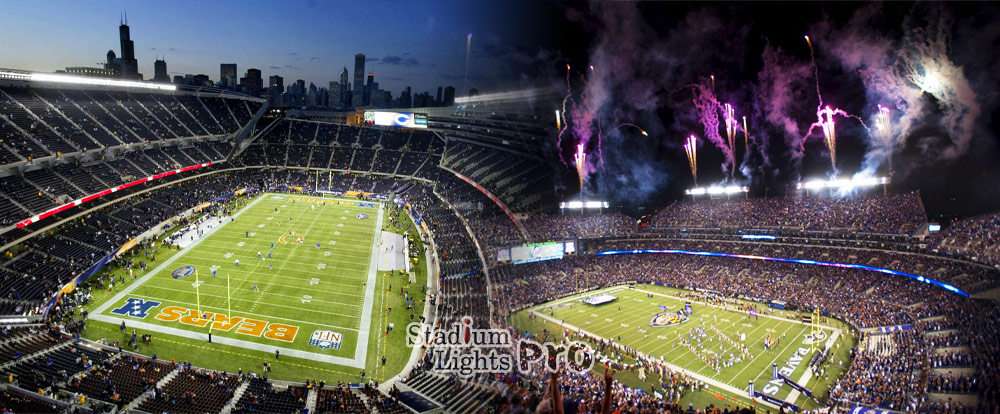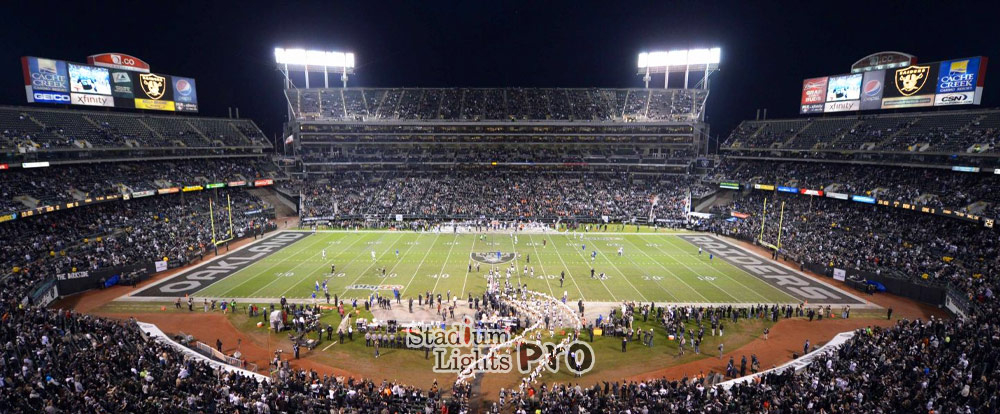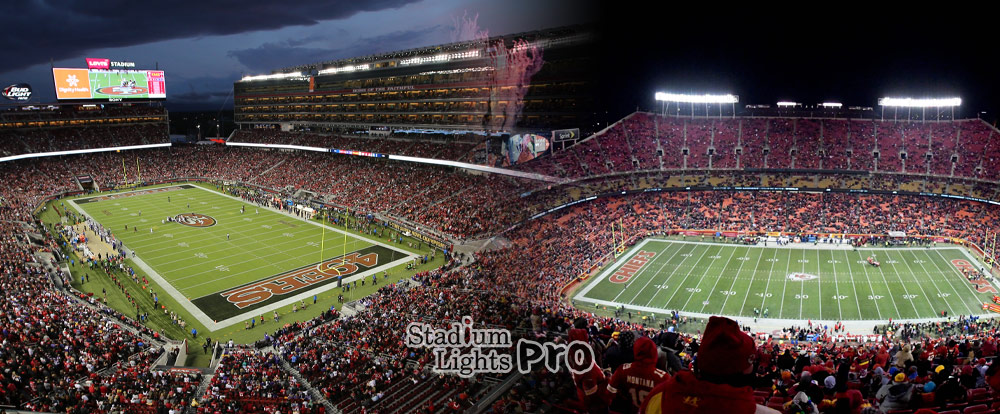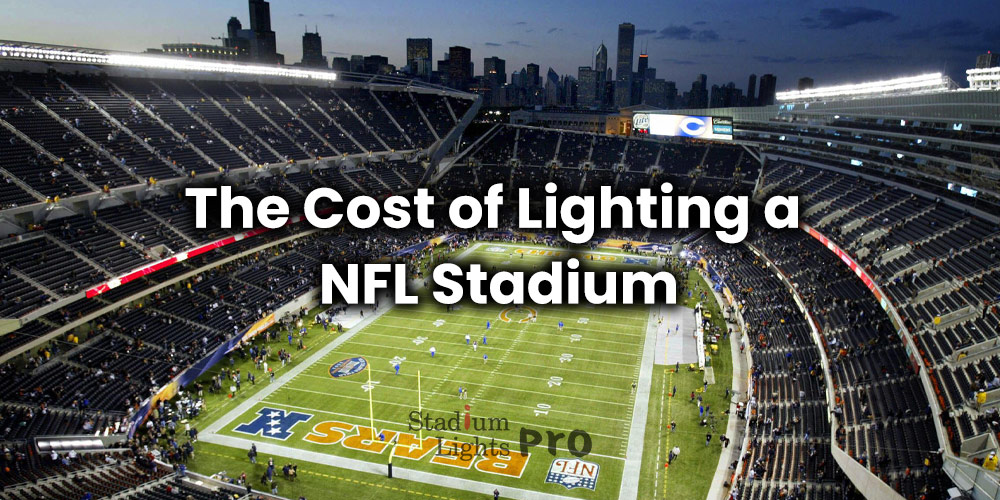Lighting is a crucial aspect of NFL stadiums, and the cost of lighting is an essential consideration for teams and organizations when planning and operating these facilities.
Table of Contents
ToggleImportance of lighting in NFL stadiums
Providing visibility

Lighting is a vital aspect of NFL stadiums for a number of reasons. One of the most obvious reasons is to provide visibility for players, coaches, officials, and fans during games and events. Adequate lighting is necessary to ensure that everyone in the stadium can see the action on the field, which is critical for the safety and enjoyment of all parties involved.
Enhancing the game day experience
A well-designed lighting system can enhance the atmosphere of the stadium and create a more immersive and engaging experience for fans. For example, many NFL stadiums use dynamic lighting systems that can change the color and intensity of the lights based on the action on the field or the mood of the crowd. This can create a more exciting and dynamic atmosphere, and can also be used to create special effects or displays during halftime shows or other events.
Branding and marketing efforts
Many NFL teams have distinctive lighting schemes and displays that are associated with their brand, and these can be used to create a unique and memorable experience for fans.
Initial installation costs
Factors that can impact initial installation costs
Size of stadium

The size of the stadium is one of the most significant factors that can impact the initial installation costs of a lighting system. Larger stadiums will require more lights and a more complex lighting system to ensure adequate visibility and coverage throughout the entire venue. This can significantly increase the initial installation costs.
Design of stadium
The design of the stadium can also impact the initial installation costs of a lighting system. Stadiums with more complex designs, such as those with retractable roofs or multiple levels, may require more lights and a more complex lighting system to ensure adequate visibility and coverage. This can increase the initial installation costs compared to simpler designs.
Type of lighting system
The type of lighting system being used can also impact the initial installation costs. Traditional lighting systems, such as those using metal halide or high-pressure sodium lights, can be less expensive to install compared to more advanced systems using LED lights or other technologies. However, these traditional systems may also be less energy efficient and may require more maintenance over time, which can offset some of the initial cost savings. More advanced lighting systems, such as LED systems, may have higher initial installation costs, but they may also be more energy efficient and require less maintenance, which can help to reduce ongoing costs over the long term.
Examples of initial installation costs
It’s difficult to provide specific examples of initial installation costs for different types and sizes of NFL stadiums, as the cost can vary significantly depending on the specific characteristics of the stadium and the lighting system being used. However, here are a few estimates that can give you an idea of the range of costs that may be involved:
Small stadium (seating capacity of 40,000-50,000)
The initial installation costs for a lighting system in a small NFL stadium with a seating capacity of 40,000-50,000 may range from $500,000 to $750,000. This is based on estimates for the installation of a traditional lighting system using metal halide or high-pressure sodium lights. The cost may be higher if a more advanced lighting system, such as an LED system, is used.
Medium stadium (seating capacity of 50,000-70,000)
The initial installation costs for a lighting system in a medium NFL stadium with a seating capacity of 50,000-70,000 may range from $750,000 to $1 million. This is based on estimates for the installation of a traditional lighting system using metal halide or high-pressure sodium lights. The cost may be higher if a more advanced lighting system, such as an LED system, is used.
Large stadium (seating capacity of 70,000+)
The initial installation costs for a lighting system in a large NFL stadium with a seating capacity of 70,000+ may be upwards of $1 million. This is based on estimates for the installation of a traditional lighting system using metal halide or high-pressure sodium lights. The cost may be higher if a more advanced lighting system, such as an LED system, is used.
Ongoing energy costs

Factors that can impact ongoing energy costs
There are several factors that can impact the ongoing energy costs of operating the lights in a NFL stadium, including:
Size of stadium
The size of the stadium is one of the main factors that can impact the ongoing energy costs. Larger stadiums will require more lights and will consume more energy to operate, which can drive up the energy costs.
Type of lighting system
The type of lighting system being used can also impact the ongoing energy costs. Traditional lighting systems, such as those using metal halide or high-pressure sodium lights, may be less energy efficient compared to more advanced systems using LED lights or other technologies. As a result, stadiums using traditional lighting systems may have higher ongoing energy costs compared to those using more advanced systems.
Number of events
The number of events held at the stadium can also impact the ongoing energy costs. The more events that are held at the stadium, the more energy will be consumed by the lighting system. This can increase the ongoing energy costs for the stadium.
Examples of ongoing energy costs
It’s difficult to provide specific examples of ongoing energy costs for different types and sizes of NFL stadiums, as the cost can vary significantly depending on the specific characteristics of the stadium and the lighting system being used. However, here are a few estimates that can give you an idea of the range of costs that may be involved:
Small stadium (seating capacity of 40,000-50,000)
The ongoing energy costs for a lighting system in a small NFL stadium with a seating capacity of 40,000-50,000 may range from $50,000 to $100,000 per year. This is based on estimates for the operation of a traditional lighting system using metal halide or high-pressure sodium lights. The cost may be lower if a more advanced lighting system, such as an LED system, is used.
Medium stadium (seating capacity of 50,000-70,000)
The ongoing energy costs for a lighting system in a medium NFL stadium with a seating capacity of 50,000-70,000 may range from $100,000 to $200,000 per year. This is based on estimates for the operation of a traditional lighting system using metal halide or high-pressure sodium lights. The cost may be lower if a more advanced lighting system, such as an LED system, is used.
Large stadium (seating capacity of 70,000+)
The ongoing energy costs for a lighting system in a large NFL stadium with a seating capacity of 70,000+ may be upwards of $200,000 per year. This is based on estimates for the operation of a traditional lighting system using metal halide or high-pressure sodium lights. The cost may be lower if a more advanced lighting system, such as an LED system, is used.
The number of events held at the stadium can also impact the ongoing energy costs, as the more events that are held, the more energy will be consumed by the lighting system.
Ways to reduce ongoing energy costs
There are several ways that teams and organizations can reduce the ongoing energy costs of operating the lights in a NFL stadium, including:
Implement energy-efficient lighting technologies
One of the most effective ways to reduce ongoing energy costs is to implement energy-efficient lighting technologies, such as LED lights. LED lights are known for their energy efficiency, and can help to reduce energy consumption and costs.
Implement lighting control systems
Another way to reduce energy costs is to implement lighting control systems that can automatically adjust the brightness and intensity of the lights based on the time of day and the type of event being held. This can help to reduce energy consumption and costs by only using the lights when they are needed.
Conduct regular maintenance and repairs
Regular maintenance and repairs of the lighting system can help to ensure that the lights are functioning properly and efficiently, which can help to reduce energy consumption and costs.
Use natural light when possible
Some NFL stadiums have been designed to take advantage of natural light, which can help to reduce the need for artificial lighting and lower energy costs.
There are a variety of ways that teams and organizations can reduce the ongoing energy costs of operating the lights in a NFL stadium, including implementing energy-efficient technologies, implementing lighting control systems, conducting regular maintenance and repairs, and using natural light when possible.
Factors that can impact the overall cost
Location of the stadium (energy and labor costs)
The location of the stadium can impact the overall cost of lighting in a number of ways. One factor to consider is the cost of energy in the region. If the stadium is located in an area with high energy costs, the ongoing energy costs for operating the lights may be higher compared to a stadium located in an area with lower energy costs.
Another factor to consider is the cost of labor in the region. If the stadium is located in an area with high labor costs, the cost of installing and maintaining the lighting system may be higher compared to a stadium located in an area with lower labor costs.
Overall, the location of the stadium can impact the overall cost of lighting by influencing the energy and labor costs associated with the lighting system. Teams and organizations should consider these factors when planning and operating a NFL stadium.
Type of events held at the stadium
The type of events held at the stadium can also impact the overall cost of lighting. Different types of events may require different types and levels of lighting, which can impact the energy consumption and costs of the lighting system.
For example, a football game will typically require a different level of lighting compared to a concert or convention. Football games may require more intense lighting to ensure that players, coaches, officials, and fans can see the action on the field, while concerts or conventions may require more flexibility and adaptability in the lighting system to support different types of performances or displays. As a result, the type of events held at the stadium can impact the overall energy consumption and costs of the lighting system.
Overall, teams and organizations should consider the type of events that will be held at the stadium when planning and operating the lighting system, as this can impact the overall cost of lighting.
Lighting design and layout
The lighting design and layout can also impact the overall cost of lighting in a NFL stadium. A well-designed lighting system can help to reduce energy consumption and costs by ensuring that the lights are placed in strategic locations to maximize coverage and visibility while minimizing energy usage.
On the other hand, a poorly designed lighting system may result in wasted energy and higher costs, as lights may be placed in less efficient locations or may be used unnecessarily.
The lighting design and layout can have a significant impact on the overall cost of lighting in a NFL stadium. Teams and organizations should carefully consider the lighting design and layout when planning and operating the lighting system in order to maximize efficiency and minimize costs.
Maintenance and repair costs
Maintenance and repair costs refer to the costs associated with maintaining and repairing the lighting system over time. These costs can include the cost of replacing bulbs, repairing equipment, and conducting regular maintenance and inspections.
The maintenance and repair costs of a lighting system can be impacted by a variety of factors, including the type of lighting system being used, the age of the system, and the level of usage. Traditional lighting systems, such as those using metal halide or high-pressure sodium lights, may require more maintenance and repairs over time compared to more advanced systems using LED lights or other technologies. In addition, older lighting systems may require more maintenance and repairs compared to newer systems. Finally, the level of usage can impact the maintenance and repair costs, as systems that are used more frequently may experience more wear and tear and may require more maintenance and repairs.
About NFL and its stadiums
The National Football League (NFL) is a professional American football league consisting of 32 teams, divided equally between the National Football Conference (NFC) and the American Football Conference (AFC). The NFL is one of the four major professional sports leagues in North America, and the highest professional level of American football in the world.
NFL stadiums are some of the largest and most technologically advanced venues in the world, with many seating over 70,000 fans. These stadiums are known for their impressive size, design, and amenities, and are often considered architectural marvels. Some of the most iconic NFL stadiums include Lambeau Field in Green Bay, Wisconsin, home of the Green Bay Packers; AT&T Stadium in Arlington, Texas, home of the Dallas Cowboys; and Levi’s Stadium in Santa Clara, California, home of the San Francisco 49ers.
In addition to hosting football games, many NFL stadiums also host a variety of other events, including concerts, conventions, and other large-scale events. As a result, the lighting systems in these stadiums are designed to be flexible and adaptable, able to support a wide range of events and activities.
Conclusion
The overall cost of lighting in a NFL stadium can be impacted by a variety of factors, including the initial installation costs, ongoing energy costs, location of the stadium, type of events held at the stadium, lighting design and layout, and maintenance and repair costs. Teams and organizations should carefully consider these factors when planning and operating the lighting system in order to maximize efficiency and minimize costs. By understanding the factors that can impact the overall cost of lighting, teams and organizations can make informed decisions that help to optimize the lighting system in their NFL stadium.
At StadiumLightsPro, we offer free lighting design services to our clients to help them plan and implement the perfect lighting solution for their project. Whether you are planning a lighting installation for a NFL stadium or any other type of venue, we encourage you to send us the information about your lighting project. Our team of lighting design experts will work with you to develop a customized lighting plan that meets your needs and budget. We are committed to helping our clients achieve the best possible results with their lighting projects, and our free lighting design services are just one way we do that. Contact us today to learn more about how we can help you with your lighting project.

